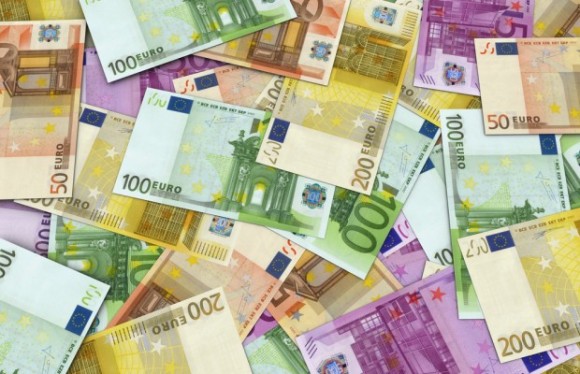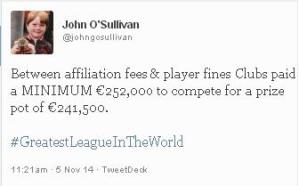There are two aspects of sports commentary I find particularly tiresome. The first is the use of shock tactics by career pundits to stay ‘current’ in their off season, the second is the insecurity of commentators who seek to define their sport in comparison to others. Joe Brolly brought both together in recent weeks in a saga which started when he offered his opinions on Roy Keane’s “deep-seeded psychological issues” before calling him a “soccer coaching Kardashian”. Brolly also said the following;
“It always amuses me to hear soccer players described as role models. They are nothing of the kind.”
Stephen Hunt waded into the conversation using his weekly column [of which many had been unaware] and emerged poorly as the public ignored the nub of his poorly made point; competing at the Elite level of any sport requires an individual to make sacrifices. Brolly responded by throwing a blanket over soccer players on the basis of class and education,
“It never ceases to amuse me when you see these young fellas – many of whom have have spent their lives playing soccer at the expense of education and come from very strong working class backgrounds – being described as role models because they’re famous.”
His comment has some truth of course, Football players are not role models. However, his snobbish implication behind the comments is ridiculous, and deserves criticism.
Football players are not role models. GAA stars are not role models. Rugby stars are not role models, neither are cyclists, swimmers and basketball players. It’s not your chosen sport which defines you as a role model, it’s your behaviour. There are footballers, hurlers and rugby players who are fantastic role models. There are footballers, hurlers and rugby players who are idiots and gobshites. Those in the public eye who uses their status and position to set a positive example for others and/or those who choose to contribute to their wider community can be role models. It’s down to the individual, not the sport.
There are no moral sports, there are no noble sports. There are moral and noble individual sportspeople, there are immoral and ignoble sportspeople. All sports offer great moments, some of those capture the imagination of an audience beyond that which the sport normally enjoys. Equally all sports regularly offer up turgid events and performances, moments that cause even the die-hard fans to shake their heads and ask ‘why do we bother’.
There’s an insecurity in being unable to enjoy your sport or your sport’s heroes without making immediate comparison with other sports or heroes in other codes. A big tackle in a rugby game leads to comparisons to diving and feigning injury in soccer; there was a ridiculous opinion piece in the Irish Independent recently by a commentator terrified that soccer culture was lowering the tone at Rugby games. An epic amateur hurling encounter leads to pundits discussing the money paid in other codes, and the pace and excitement levels of other sports. it was a card Brolly was happy to play when discussing Stephen Hunt;
“I don’t imagine Stephen would have lasted five minutes in the Ulster club final last Sunday. I wouldn’t fancy his chances standing on the edge of the square with Patsy Bradley.”
Hunt probably wouldn’t last that long in a high level Gaelic Football match, neither would Lionel Messi, LeBron James, Katie Taylor or Johnny Sexton. Likewise, Patsy Bradley wouldn’t last long in the English Premier league, the NBA, a World Championship boxing ring or an Irish Rugby international. These are ridiculous comparisons to make, Elite sportsmen and women make sacrifices to get to the top of their chosen sport, not every sport..
For the Elite inter-country GAA player the sacrifice may be his family and social life, cramming four of five days training [for no wage] around a full-time job, mostly in the depths of winter. For an professional footballer it can actually be education that is sacrificed, as travelling to the UK is seen as necessary at too young an age. But any footballing biography deals, at some stage, with family sacrifices similar to those of the GAA player; the missed Christmas for a St.Stephen’s Day fixture, the insecurity of short term contracts, moving from club to club, the lack of a fall-back option if your career takes a negative turn.
We can respect the commitment and sacrifice of people who compete at the Elite level of any sport. We don’t need to compare sports, we don’t need to compare sportspeople across codes. So why is Brolly doing this, why was he even commenting on Roy Keane in the first place?
Controversy isn’t new to Brolly, he regularly finds himself in arguments, mostly within GAA circles e.g. the comments that angered Kerry footballer Kieran Donaghy a few months back, or that which required his apology to Sky’s GAA anchor Rachel Wyse.
It’s the quietest time of the year for Brolly, the Championship season is a memory yet he’s in the public eye. He’s on Newstalk, RTE and splashed across print and online media. No one at RTE is going to lose his number between now and the start of the 2015 Championship season, when the RTE panel might need to be freshened up. He can enjoy Christmas safe in the knowledge that the producers in RTE sport will see his presence as a draw for viewers.
Whether they earn their money in GAA [Brolly] or football [e.g. Eamonn Dunphy], the most successful carer pundits offer a particular skill set. They don’t educate, they don’t really inform. They realise their function is to entertain and build controversy and discussion beyond their ten minutes chat around a sporting event.. If Keane is a “soccer coaching Kardashian”; Brolly with his controversial comments, designed to pick arguments and keep him in the public eye, seems to be targeting a niche as GAA’s Katie Hopkins. He’s played a blinder, he might even last five minutes on the RTE Soccer panel.
Note: While I’ve worked in Football in recent years and football is my own chosen sport, I do enjoy GAA and sit on the Juvenile Development Committee of my local GAA club.



















